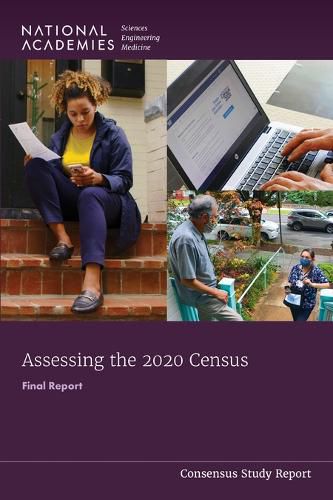Readings Newsletter
Become a Readings Member to make your shopping experience even easier.
Sign in or sign up for free!
You’re not far away from qualifying for FREE standard shipping within Australia
You’ve qualified for FREE standard shipping within Australia
The cart is loading…






Since 1790, the U.S. census has been a recurring, essential civic ceremony in which everyone counts; it reaffirms a commitment to equality among all, as political representation is explicitly tied to population counts. Assessing the 2020 Census looks at the quality of the 2020 Census and its constituent operations, drawing appropriate comparisons with prior censuses. The report acknowledges the extraordinary challenges the Census Bureau faced in conducting the census and provides guidance as it plans for the 2030 Census. In addition, the report encourages research and development as the goals and designs for the 2030 Census are developed, urging the Census Bureau to establish a true partnership with census data users and government partners at the state, local, tribal, and federal levels.
Table of Contents
Front Matter Abstract Summary 1 Introduction 2 Overview of the 2020 Census 3 Age Heaping as an Indicator of Data Quality 4 Coverage Measurement in the 2020 Census 5 Master Address File 6 Self-Response to the Census 7 Nonresponse Followup 8 Use of Administrative Records for Enumeration in the 2020 Census 9 Measurement of the Group Quarters Population 10 Measurement of Race and Ethnicity 11 Impact of New Confidentiality-Protection Methods on 2020 Census Data Products 12 Learning from 2020, Preparing for 2030 References Appendixes Appendix A: Full List of Conclusions and Recommendations Appendix B: Glossary and Abbreviations Appendix C: Additional Detail and Reference on 2020 Census Operations Appendix D: Extensions of Census Coverage Evaluations Appendix E: 2020 Census Group Quarters Definitions and Type Code List Appendix F: Additional Detail and Reference on Data Products and Disclosure Avoidance Appendix G: Biographical Sketches of Panel Members and Staff
$9.00 standard shipping within Australia
FREE standard shipping within Australia for orders over $100.00
Express & International shipping calculated at checkout
Stock availability can be subject to change without notice. We recommend calling the shop or contacting our online team to check availability of low stock items. Please see our Shopping Online page for more details.
Since 1790, the U.S. census has been a recurring, essential civic ceremony in which everyone counts; it reaffirms a commitment to equality among all, as political representation is explicitly tied to population counts. Assessing the 2020 Census looks at the quality of the 2020 Census and its constituent operations, drawing appropriate comparisons with prior censuses. The report acknowledges the extraordinary challenges the Census Bureau faced in conducting the census and provides guidance as it plans for the 2030 Census. In addition, the report encourages research and development as the goals and designs for the 2030 Census are developed, urging the Census Bureau to establish a true partnership with census data users and government partners at the state, local, tribal, and federal levels.
Table of Contents
Front Matter Abstract Summary 1 Introduction 2 Overview of the 2020 Census 3 Age Heaping as an Indicator of Data Quality 4 Coverage Measurement in the 2020 Census 5 Master Address File 6 Self-Response to the Census 7 Nonresponse Followup 8 Use of Administrative Records for Enumeration in the 2020 Census 9 Measurement of the Group Quarters Population 10 Measurement of Race and Ethnicity 11 Impact of New Confidentiality-Protection Methods on 2020 Census Data Products 12 Learning from 2020, Preparing for 2030 References Appendixes Appendix A: Full List of Conclusions and Recommendations Appendix B: Glossary and Abbreviations Appendix C: Additional Detail and Reference on 2020 Census Operations Appendix D: Extensions of Census Coverage Evaluations Appendix E: 2020 Census Group Quarters Definitions and Type Code List Appendix F: Additional Detail and Reference on Data Products and Disclosure Avoidance Appendix G: Biographical Sketches of Panel Members and Staff